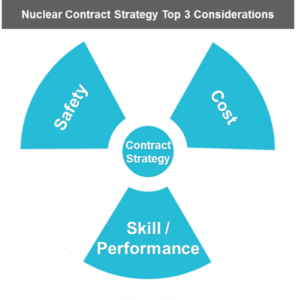Today’s nuclear plants operate in a tough, competitive energy landscape where financial margins have become razor thin. Now more than ever, leaders must leverage cost management to meet the rising expectations for flawless and cost-effective performance as demanded by both regulators and customers. Nuclear leaders understand that controlling operation and maintenance (O&M) expenditures are critical to effective cost management. But, where do you begin? In this article, ScottMadden recommends analyzing how your team selects and manages your contractor workforce.
THE IMPACT OF CONTRACT STRATEGY ON YOUR COSTS

Sixty-eight percent of a plant’s production expense is dedicated to O&M, and a huge portion of these costs is typically maintenance and construction labor expenses.
[1] For this reason, developing a strategy by which your team selects and manages the contractor workforce can create an exciting opportunity for improvement.
A contractor and supplier strategy can ensure your team is effectively managing core contractor relationships, which can help you get the most out of every contract dollar spent. It can also yield cost-saving and performance enhancement opportunities by outlining a measured contract and supplier relationship management approach, particularly for your most critical contractors.
However, your strategy should not focus solely on finding the lowest cost provider. Since safety is paramount to nuclear energy, you must ensure that contractors help reinforce the safety-focused culture and standards that you expect from your own employees. To achieve this result, your strategy should incentivize this high-level performance.
WHAT IS YOUR CONTRACT STRATEGY?
ScottMadden recently conducted a benchmarking study that asked companies to describe their nuclear contract strategies for both maintenance and construction services. The leading approach is an alliance contract where a service is essentially outsourced to a third party (the “alliance partner”) through a long-term arrangement that uses pay-for-performance incentives to help the utility achieve goals for quality, availability, etc. at a reasonable cost. Seventy-five percent of survey participants reported using alliance partner(s) for their maintenance services, and 50 percent reported using alliance partner(s) for construction services (Figure 1).
Figure 1: Nuclear Contracts for Maintenance and Construction Services
In spite of the popularity of alliance contracts, the survey results highlight that there is a range of options available when selecting a contract strategy and that no particular strategy dominates the industry. Given that there is no universal answer, some companies may find the process of selecting the best option overwhelming. The challenge for your company is to determine, for the given work, which contract strategy is best tailored for your plant’s needs.
HOW DO YOU OPTIMIZE YOUR STRATEGY?
Deciding which strategy is best for your plant can be achieved by identifying the right balance across a number of factors. Responses to the benchmarking survey listed a number of issues that are typically considered during this decision-making process, including flexibility, talent access, oversight burden, training quality, and competition amongst the vendors. Each of these factors can impact your operation differently, and a unique approach is required to determine the best solution. Recently reported experiences include the following (see Figure 2):
The responses from Figure 2 demonstrate that companies have seen mixed results from each strategy. Some companies have seen reductions of up to 50 percent in vendor overhead and profit markups thanks to the competition created by
multiple alliances. Conversely, other companies have been able to reduce administrative expenses and simplify their procurement processes by focusing on a
single alliance structure.
In contrast to these benefits, some companies with multiple alliances reported negative impacts stemming from additional oversight burden, particularly with quality control and the division of responsibility. Similarly, companies that utilized a single alliance reported a lack of availability for specific skill sets, which required them to bid out multiple work streams.
The key takeaway is that these concepts can provide both benefits and challenges to your company. This critical fact reinforces the need to develop a smart and measured approach to determine the appropriate balance for each function of your business, whether you are contracting for seasonal outage work or day-to-day staff augmentation.
When optimizing your contract strategy, it is crucial to work with a partner who understands your business. ScottMadden knows nuclear. We have delivered projects to more than 80 percent of the commercial nuclear generation stations in North America. We understand your commitment to safe and reliable nuclear operations, especially while addressing operational changes. From benchmarking industry peers to evaluating vendors, ScottMadden does what it takes to help you achieve your goals of safe and reliable breaker-to-breaker runs.
[1] Source: http://www.nei.org/Knowledge-center/nuclear-statistics/costs-fuel,-operation,-waste-disposal-life-cycle/us-electricity-production-costs-and-components
